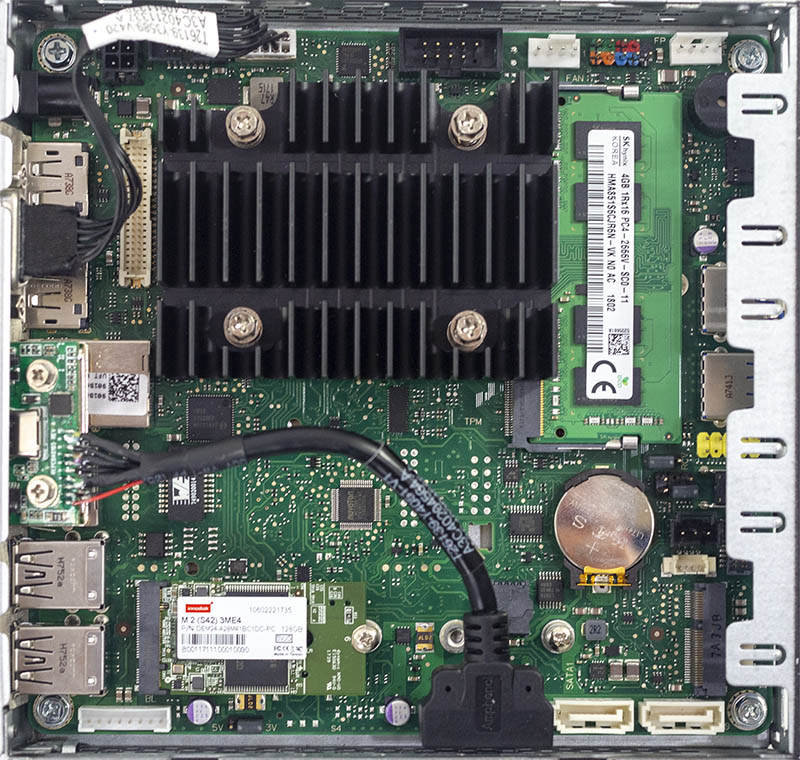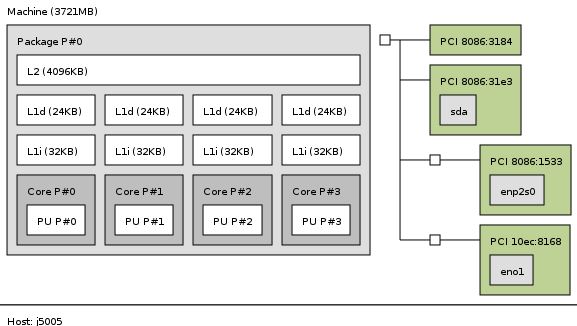Fujitsu D3544-S Test Configuration
Since this is a BGA part affixed to its motherboard, we are testing this in an industrial embedded platform from Fujitsu, the Fujitsu D3544-S3.
- Motherboard: Fujitsu D3544-S3
- CPU: Intel Pentium Silver J5005
- RAM: 1x 4GB DDR4-2666V SODIMM running at 2400MHz
- SSD: Innodisk 128GB M.2 SATA
Our platform is extremely compact, and the best part is that it is fanless even in a fairly wide temperature range.

With dual 1GbE NICs, room for an M.2 SSD and a Bluetooth/ Wi-Fi M.2 card and the Intel Pentium Silver J5005 onboard this is a compact platform that can be deployed almost anywhere.
The Fujitsu D3544-S platform has several variants which include different Gemini Lake SKUs. We are testing the top-end offering that is available at this time denoted by the Fujitsu D3544-S3 notation.
Fujitsu D3544-S Topology and Block Diagram
With a trend toward multi-chip packages in the higher-end of the server realm, we have started publishing topologies of the platforms we test. The Intel Pentium Silver J5005 is a SoC which makes the block diagram relatively simple.

Here you can see all of the devices directly attached to the Intel Pentium Silver J5005 SoC.
Next, we are going to take a look at our Fujitsu D3544-S benchmarks, we are then going to focus on power consumption then conclude with our final words on the processors.




I note 2 SATA headers on the MB, are there power connectors/headers also provided
Pity that it does not support ECC RAM. IMHO for majority of industrial usage, this is a must have feature. Otherwise board looks fantastic.
“First, we would prefer two Intel i210 NICs instead of a Realtek plus an Intel. That would open the door to a wide range of applications.”
You could say that again. With a pair of intel nics this could be a great candidate for smb pfsense box.
Also curious on OpenSSL testing – is AES-NI is used by default?
I do not like the growing reliance starting about 10 years ago by manufactures and for the sake of “cost reduction engineering” to remove the physical hard switch for completely turning off the power to a device, low voltage or not, thus not unplugging a live source to perform the task of full electrical power shut down.
I learned from intense formal education in US Navy schools to decades of hands on mentoring by those many years my senior (knowing well from practice what is improper and why), to myself being a former instructor for Basic Electricity and Electronics, to having years of experience with integrated applications where access is not practical, such that the user method of physically unplugging a device as a means to turning off the power, is not a good electrical engineering practice. Most receptacles that are for low voltage DC are not designed with the intent to be used as the principle means to turn on and off a device. That is why even though low power DC and AC, external power supplies with generic use certifications have been packaged for many decades to avoid having to test a high voltage (110AC) circuit and related power supply for newly designed low power appliance, had a hard switch, not just a momentary, state change, switch.
Why the aren’t any numbers in the benchmarks?! This isn’t serious because I can’t compare them to my current machines… Please fix this.
@Peter K,
It does mention in the article that they don’t provide all the data that they collect because they also provide consultancy and testing services. We don’t pay for STH so they can provide whatever they like, if it’s business critical for you to know the numbers then you could always contact STH and get them?
I think Fujitsu D3433-S2 Industrial Mini ITX with Kabby Lake is more flexible:
1. 3x nvme with x8 riser or maybe 5x nvme with x16 riser
2. 1080p gaming rig with 17-21w idle on w10 desktop with Quadro P1000+1x nvme+2x5Tb slim hdd+wifi.
3. Opnsense box with x16 riser+ mellanox 4 100GBE
@Laugh|nGMan You are comparing apples to oranges. The J5005 is embedded and has 6 PCIE 2.0 lanes. The Q170 chipset has 20 PCIE 3.0 lanes, of course its going to be more flexible.
As with the sketchier very small format devices available from direct from China vendors like Qotom, the lack of a second DIMM slot is a disappointment, as these SoCs all support Dual Channel RAM — a lot of that bus bandwidth and multicore capability is wasted when you can’t use it. It should also be noted that the Qotom and similar routinely include a pair of Intel i211 NICs in a passively cooled case and heat is not a problem. Intel i-series NICs aren’t remotely the kind of fireballs they were in the pro/1000 era when you absolutely had to have air moving over them.
Sort of surprised there is no HDMI option for flexibility.
Re: https://www.servethehome.com/fujitsu-d3544-s-review-an-industrial-mini-stx-platform/4/#comment-464076
@Park McGraw I completely agree with you. I believe that this is the sort of thing that is used a cost-cutting measure. The absence of real power switches on electrical devices these days is worrying, and I think this is a good prompt for me to further improve my soldering skills.